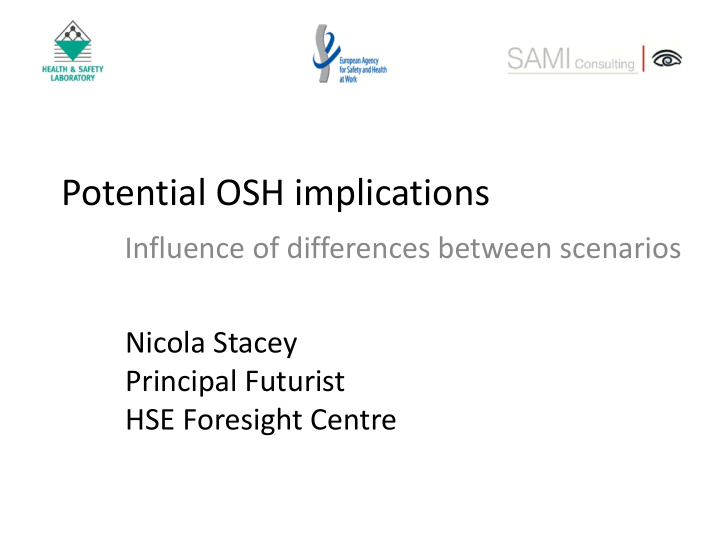



Potential OSH implications Influence of differences between scenarios Nicola Stacey Principal Futurist HSE Foresight Centre
ICT-ETs facilitate and drive • New work equipment and tools • New ways of organising and managing work • Changes to the working environment • Changes in workforce characteristics • Changing responsibilities for OSH • Different skills, knowledge and info. needs
Work equipment and tools • Automation and autonomy • Internet of all things • Advanced manufacturing • Wearable devices • Artificial intelligence • AR, VR and ‘natural’ Human Machine Interfaces • Customisable, complex, integrated • Ever changing and advancing
Implications (work equip. & tools) • Hazardous environments • Situational awareness • Better access to work • Risk and work intensification • Cognitive demand vs task deprivation • Ergonomics and sedentary nature • Constant monitoring and privacy • Cyber-security
Business structures • Management by algorithm / app • Micro high turn-over enterprises • Asset-light (work equip. and offices) • Low profit margins • Decentralised and/or local • Consumer customisation • Collaborative employment
Employment Status – (pseudo) self employed – Casual, multiple employers Hierarchies – AI boss, own boss, flatter, remote Relationships – Peer support, knowledge transfer – Collective bargaining
Workforce characteristics • Dispersed • Diverse • Multi-disciplinary • Autonomous • New • Nomophobic
Implications of new ways of working • Workers OSH needs diverse • Workplaces non-controlled / non-standardised • Working time non-controlled / non-standardised • Lone working
NOT MY PROBLEM NOT MY PROBLEM I just finance the I just run the workspace – OSH* Platform – OSH* is not my problem is not my problem I just buy the “THE products – OSH* is PLATFORM” I just fix the not my problem machines – OSH* is not my problem There’s no employers or managers round here – I just design the OSH* is not our problem templates – OSH* is not my problem Hmm… do we have a problem?? * OSH = “occupational safety & health”
Skills, knowledge and information • ICT skills • Personal and inter-personal • Life-long and self-directed • Knowledge transfer • Deskilling • Corporate memory
Features of ‘evolution’ scenario • Manageable pace of change • Government recognise importance of OSH • Worker trust and confidence in regulator • Limited public and private funding • Skills shortages • Diffusion of technology more than innovation • Automated systems, cobots and narrow AI
Features of ‘transformation’ scenario • Good OSH is expectation of society & built-in • Consensual and evidence based approach • Funding for quality research and lots of data • Skilled multi-generational monitored workforce • Loss of employment hierarchies • Blurring of work and private life • Lights-out factories • Autonomy, AI, bionics, advanced HMIs
Features of ‘exploitation’ scenario • Lack of government leadership • Lack of support, trust or funding • Poor regulatory frameworks • Frequent job changes and change to jobs • Severe skills gaps • Responsibilities transferred to worker • Micro-communities • Autonomy, AI, cobots, advanced HMIs
Features of ‘fragmentation’ scenario • Lack of government leadership • Lack of support or funding • Manageable pace of change (mostly) • Skills gaps, poor knowledge transfer • Rise of grey economy • Counterfeiting • Mix of old and new technology • Poor cyber-security
Summary of OSH implications • Opportunities to reduce OSH risks • Opportunities to better manage OSH • Existing risks in new contexts / sectors • Ongoing trends for recognised emerging risks • Some new and potential as yet unknown risks • Psycho-social and organisational factors very important
Presents OSH challenges for • Business management of OSH • Education and training • Regulation • Inspection • Health surveillance • Occupational health services • Worker representation • Research
Recommend
More recommend